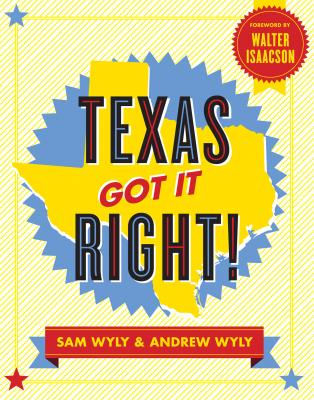ТОП просматриваемых книг сайта:
Texas Got It Right!. Sam Wyly
Читать онлайн.Название Texas Got It Right!
Год выпуска 0
isbn 9781595910769
Автор произведения Sam Wyly
Жанр Экономика
Издательство Ingram
markets driven by everything from consumer tech to
agriculture to clean energy. They also find fewer
obstacles to building a career or a business than in
any other big states. Andrew and I see in Texas a
model for the other states and for Washington to
follow. That Place on the Potomac needs to shrink
itself and be less of a burden on Texans and the other
folks in America who work for a living.
Today, political, economic, and cultural influ-
ence in this country is shifting south, away from its
traditional seats of power in the Northeast and on
the Left Coast. For us the reason is as clear as day:
California, New York, and Illinois Got It Wrong.
Texas Got It Right.
TEXAS GOT IT RIGHT!
17
“Appomattox determined that the North would
establish the rules for our Union ... for the next hun-
dred years. The North would set the freight rates so
damaging to the South. The North would determine
the tariffs that made it so rich and kept the South so
poor. The North would determine everything, it
seemed, and would do so perpetually. But look at
the situation today. Where is the power flowing?
Always to the South. Where are the seats in Congress
coming? To Texas and Florida. Where would you
like to live if you were young and active and hope-
ful? Vermont? Or the Sunbelt?”
—James Michener, Texas, 1985
TEXAS GOT IT RIGHT!
18
As new jobs and prosperity have driven population
growth in the state, Texas’s legislative and electoral
oomph have grown right along with it. In fact, the
Lone Star State is at the center of a slow, steady
shift in the political landscape of the United States.
Since 1940, seventy-nine congressional seats have
drifted from the Midwest and the Northeast to the
South and the West—and about 18 percent of those
seats now belong to Texas, whose congressional
delegation has grown for the past seven consecutive
decades. The picture in the Electoral College,
whose delegates send a candidate to the White
House every four years, is similarly striking. The
2010 Census awarded Texas 38 electors, four more
than it possessed after the 2000 count, and the most
gained by any state. Meanwhile, the electoral clout
of Rust Belt and Northeast power centers like
Illinois, New York, and Pennsylvania is declining,
and California has flatlined.
TEXAS GOT IT RIGHT!
19
When the early Texans revolted against Mexican
rule and gave birth to a new nation, the Republic of
Texas, it was a do-it-yourself thing. It all started
with an old cannon, a homemade flag, and a cocky
motto that’s as resonant today as it was in October
1835. That’s when colonists in a settlement named
Gonzales decided to fight the one hundred troops
that Mexico’s dictator, General Santa Anna, had
sent to take possession of the town’s single rusting
cannon. Oddly enough, that gun— the “It” in “Come
and Take It”—had originally been sent from Mexico
to help the Anglo colonists fight the Comanche
Indians, who had wiped out San Saba and other
Spanish missions. In fact, it was the Mexican
regime that had invited those Anglo settlers to the
Texas territories in the first place, as a defense
20
TEXAS GOT IT RIGHT!
against Indian raids. But times had changed. The dic-
tator who had overthrown Mexico’s democratic
government now wanted to rule the “unruly” Texans.
The defenders of Gonzales rallied under the crude
flag above, which was hastily made from the silk of a
local gal’s wedding dress. After a brief battle, the first
of the Texas Revolution, the people of Gonzales kept
their cannon. But the skirmish wasn’t really about the
gun (the thing barely worked). It was about defending
local self-government from distant, centralized power—
a notion that’s as dear to Texans today as it was to the
Gonzales guys in 1835. And just like your typical
present-day Texan, those grassroots rebels knew the
value of fighting words. “Come and Take It.” You
couldn’t pay an ad agency a monster fee to come up
with a better slogan than that.
The Battle of Gonzales (see opposite page) in
October 1835 may have provided the spark for the
Texas Revolution, but the settlers who won it proba-
bly didn’t anticipate just how hot the flames of their
new war would burn. By early the next year, six thou-
sand Mexican troops had poured into Texas to put
down the insurrection. Mexico’s dictator, General
Santa Anna—who in early 1835 had ransacked the
Mexican silver-mining town of Zacatecas to crush the
rebels who were fighting to preserve their freedom
under the Mexican Constitution of 1824—
issued a decree to his troops to take no
prisoners. Five months after the
rebels

